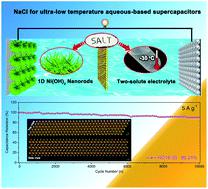当前位置:
X-MOL 学术
›
J. Mater. Chem. A
›
论文详情
Our official English website, www.x-mol.net, welcomes your
feedback! (Note: you will need to create a separate account there.)
High-rate performance aqueous-based supercapacitors at −30 °C driven by novel 1D Ni(OH)2 nanorods and a two-solute electrolyte
Journal of Materials Chemistry A ( IF 10.7 ) Pub Date : 2021-10-06 , DOI: 10.1039/d1ta07412a Wutao Wei 1, 2 , Weihua Chen 3 , Liwei Mi 2 , Jiaqiang Xu 1 , Jiujun Zhang 1
Journal of Materials Chemistry A ( IF 10.7 ) Pub Date : 2021-10-06 , DOI: 10.1039/d1ta07412a Wutao Wei 1, 2 , Weihua Chen 3 , Liwei Mi 2 , Jiaqiang Xu 1 , Jiujun Zhang 1
Affiliation

|
Extreme application environments, such as the exploration of space and living in polar regions, require electrochemical energy storage devices to operate well at ultralow temperatures. Aqueous-based supercapacitors (ASCs) have attracted much attention because of their high safety, high-rate performance, and long cycle-life. However, their application in low-temperature environments is also severely limited by the high freezing point of the aqueous-based electrolyte. In this paper, based on the ability of the coordination between Ni2+ and Cl− to restrict the longitudinal growth of Ni(OH)2 along the (0 0 1) crystal plane and the inherent ultralow freezing point of NaCl aqueous solution, cost efficient NaCl was explored for its ability to both regulate the preparation of one-dimensional (1D) Ni(OH)2 nanorods and develop a two-solute electrolyte for ASCs with ultralow-temperature resistance. The 1D Ni(OH)2 nanorods comprised bundles of finer nanorods with a diameter of about 16 nm, which could authentically shorten the transport distance of OH− and electrons, providing enough deformation space for them to interact with each other. Both the three-electrode system and assembled ASCs using this electrode material of 1D Ni(OH)2 nanorods were used to test the specific capacitances, and it was found that this material could give 1.6 times higher values than those of 2D Ni(OH)2 nanosheets at the corresponding scan rates or current densities. Further, the capacitance retention was found to gradually increase from 84.04% for NO0//AC to 96.24% for NO16//AC after 10 000 cycles at 5 A g−1. With the assistance of the two-solute electrolyte, the capacitance retention of NO16//AC at −30 °C was up to 61.1% from 0.5 to 10 A g−1, and 90.21% after 10 000 cycles at 5 A g−1. These results demonstrate not only the potential application of low-cost NaCl in energy storage systems, but also the application of ASCs in ultralow-temperature environments.
中文翻译:

由新型一维 Ni(OH)2 纳米棒和双溶质电解质驱动的 -30°C 下的高性能水基超级电容器
太空探索和极地生活等极端应用环境需要电化学储能装置在超低温下良好运行。水基超级电容器(ASCs)因其高安全性、高倍率性能和长循环寿命而备受关注。然而,它们在低温环境中的应用也受到水基电解质高凝固点的严重限制。在本文中,基于Ni 2+和Cl -之间的配位限制Ni(OH) 2纵向生长的能力沿着 (0 0 1) 晶面和 NaCl 水溶液固有的超低凝固点,探索了具有成本效益的 NaCl,因为它能够调节一维 (1D) Ni(OH) 2纳米棒的制备并开发出两种-具有超低温耐受性的 ASC 的溶质电解质。1D Ni(OH) 2纳米棒由直径约16nm的更细纳米棒束组成,可以真正缩短OH -和电子的传输距离,为它们之间的相互作用提供足够的变形空间。三电极系统和使用这种 1D Ni(OH) 2电极材料组装的 ASC纳米棒被用来测试比电容,发现在相应的扫描速率或电流密度下,这种材料可以提供比 2D Ni(OH) 2纳米片高 1.6 倍的值。此外,发现电容保持率从 NO0//AC 的 84.04% 逐渐增加到 NO16//AC 的 96.24%,在 5 A g -1 下经过 10 000 次循环后。在两种溶质电解质的帮助下,NO16//AC 在-30°C 的电容保持率从 0.5 到 10 A g -1高达 61.1%,在 5 A g -1 下循环 10 000 次后可达 90.21% . 这些结果不仅证明了低成本 NaCl 在储能系统中的潜在应用,而且还证明了 ASC 在超低温环境中的应用。
更新日期:2021-10-20
中文翻译:

由新型一维 Ni(OH)2 纳米棒和双溶质电解质驱动的 -30°C 下的高性能水基超级电容器
太空探索和极地生活等极端应用环境需要电化学储能装置在超低温下良好运行。水基超级电容器(ASCs)因其高安全性、高倍率性能和长循环寿命而备受关注。然而,它们在低温环境中的应用也受到水基电解质高凝固点的严重限制。在本文中,基于Ni 2+和Cl -之间的配位限制Ni(OH) 2纵向生长的能力沿着 (0 0 1) 晶面和 NaCl 水溶液固有的超低凝固点,探索了具有成本效益的 NaCl,因为它能够调节一维 (1D) Ni(OH) 2纳米棒的制备并开发出两种-具有超低温耐受性的 ASC 的溶质电解质。1D Ni(OH) 2纳米棒由直径约16nm的更细纳米棒束组成,可以真正缩短OH -和电子的传输距离,为它们之间的相互作用提供足够的变形空间。三电极系统和使用这种 1D Ni(OH) 2电极材料组装的 ASC纳米棒被用来测试比电容,发现在相应的扫描速率或电流密度下,这种材料可以提供比 2D Ni(OH) 2纳米片高 1.6 倍的值。此外,发现电容保持率从 NO0//AC 的 84.04% 逐渐增加到 NO16//AC 的 96.24%,在 5 A g -1 下经过 10 000 次循环后。在两种溶质电解质的帮助下,NO16//AC 在-30°C 的电容保持率从 0.5 到 10 A g -1高达 61.1%,在 5 A g -1 下循环 10 000 次后可达 90.21% . 这些结果不仅证明了低成本 NaCl 在储能系统中的潜在应用,而且还证明了 ASC 在超低温环境中的应用。











































 京公网安备 11010802027423号
京公网安备 11010802027423号